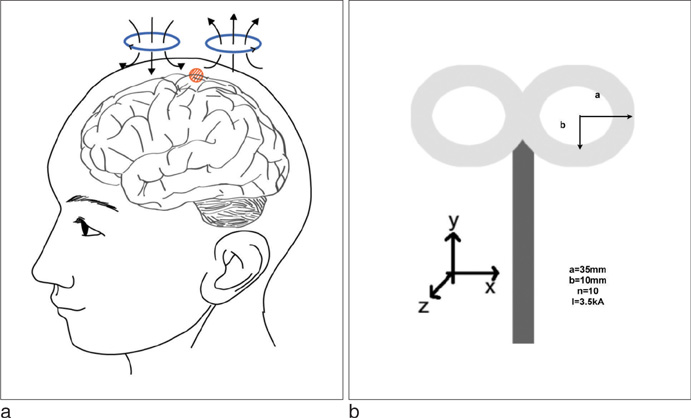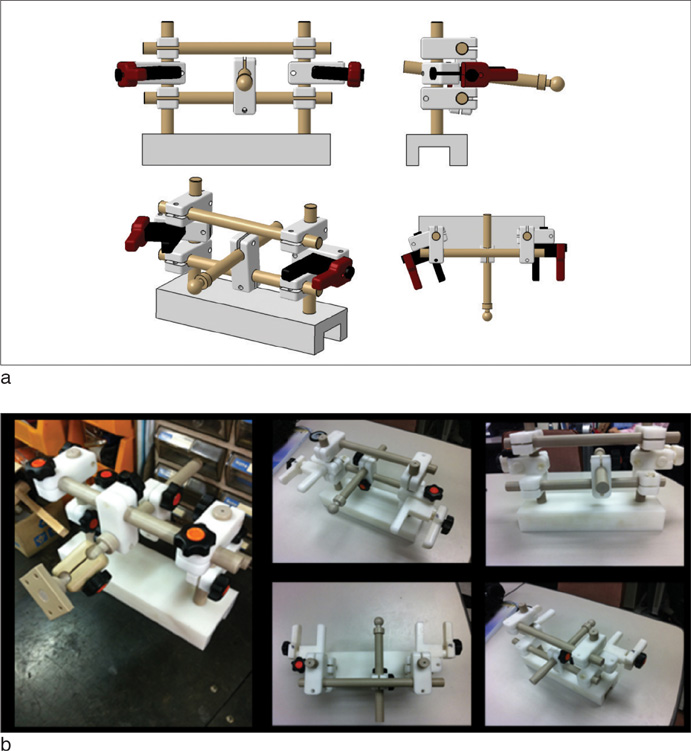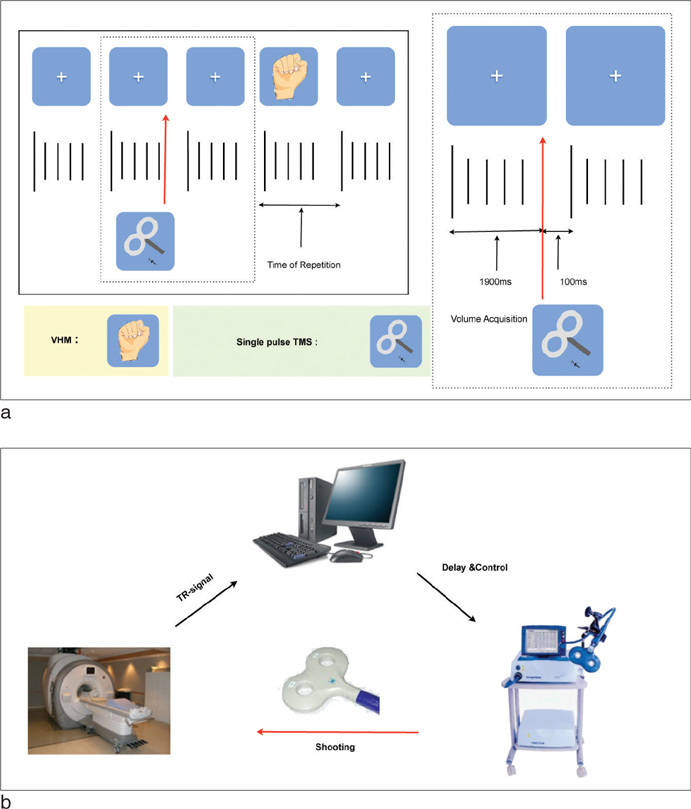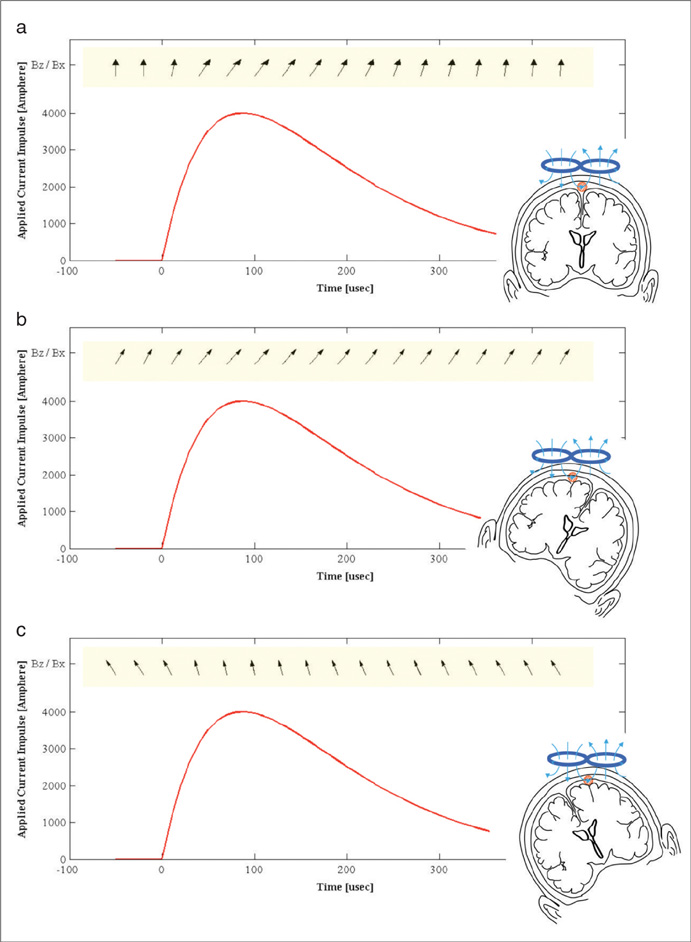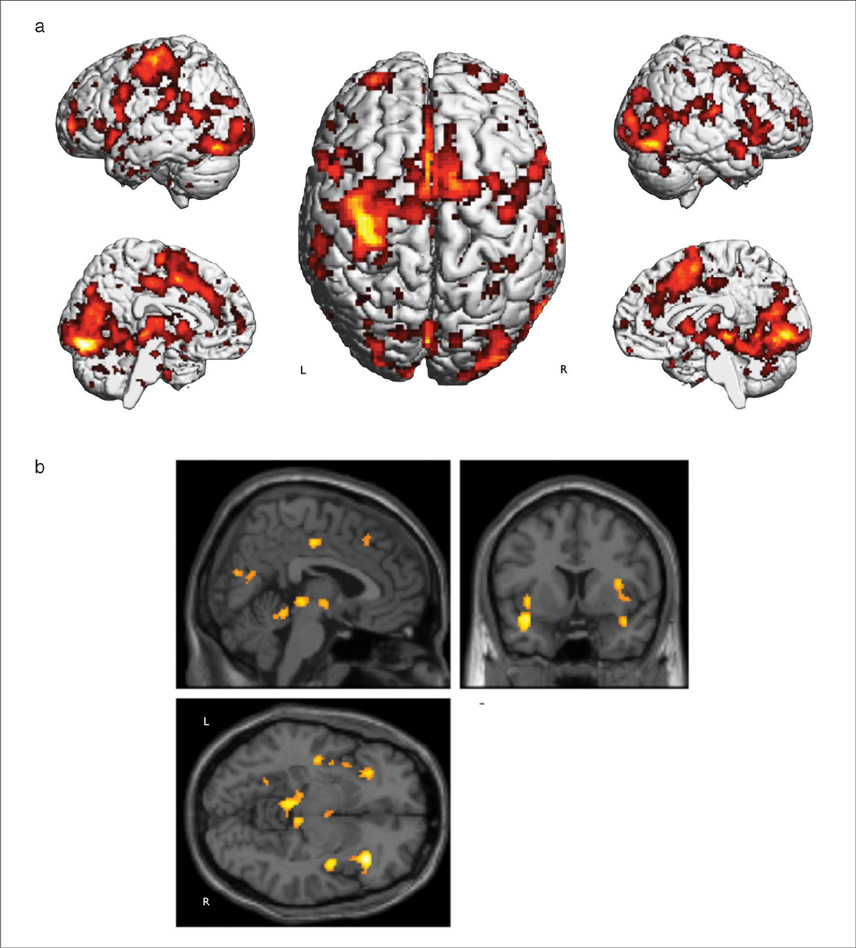J Korean Soc Magn Reson Med.
2013 Sep;17(3):169-180. 10.13104/jksmrm.2013.17.3.169.
A System for Concurrent TMS-fMRI and Evaluation of Imaging Effects
- Affiliations
-
- 1Brain Korea 21 Project for Medical Science, Yonsei University College of Medicine, Seoul, Korea. parkhj@yuhs.ac
- 2Department of Nuclear Medicine and Severance Biomedical Science Institute, Yonsei University College of Medicine, Seoul, Korea.
- 3Division of Computational Sciences in Mathematics, National Institute for Mathematical Sciences, Daejeon, Korea.
- KMID: 2206915
- DOI: http://doi.org/10.13104/jksmrm.2013.17.3.169
Abstract
- PURPOSE
The purpose of this study was to setup a concuurent transcranial magnetic stimulation (TMS)-functional MRI (fMRI) system for understanding causality of the functional brain network.
MATERIALS AND METHODS
We manufactured a TMS coil holder using nonmagnetic polyether ether ketone (PEEK). We simulated magnetic field distributions in the MR scanner according to TMS coil positions and angles. To minimize image distortions caused by TMS application, we controlled fMRI acquisition and TMS sequences to trigger TMS during inter-volume intervals.
RESULTS
Simulation showed that the magnetic field below the center of the coil was dramatically decreased with distance. Through the MR phantom study, we confirmed that TMS application around inter-volume acquisition time = 100 miliseconds reduced imaging distortion. Finally, the applicability of the concurrent TMS-fMRI was tested in preliminary studies with a healthy subject conducting a motor task within TMS-fMRI and passive motor movement induced by TMS in fMRI.
CONCLUSION
In this study, we confirmed that the developed system allows use of TMS inside an fMRI system, which would contribute to the research of brain activation changes and causality in brain connectivity.
Keyword
MeSH Terms
Figure
Reference
-
1. Barker AT, Jalinous R, Freeston IL. Non-invasive magnetic stimulation of human motor cortex. Lancet. 1985; 1(8437):1106–1107.2. Wagner T, Valero-Cabre A, Pascual-Leone A. Noninvasive human brain stimulation. Annu Rev Biomed Eng. 2007; 9:527–565.3. Wassermann EM, McShane L, Hallett M. ScienceDirect - Electroencephalography and Clinical Neurophysiology/Evoked Potentials Section: Noninvasive mapping of muscle representations in human motor cortex. Electroencephalogr Clin Neurophysiol. 1992; 85:1–8.4. Nardone R, De Blasi P, Bergmann J, et al. Theta burst stimulation of dorsolateral prefrontal cortex modulates pathological language switching: A case report. Neurosci Lett. 2011; 487:378–382.5. Funke K, Benali A. Modulation of cortical inhibition by rTMS-findings obtained from animal models. J Physiol. 2011; 589:4423–4435.6. Di Lazzaro V, Dileone M, Pilato F, et al. Modulation of motor cortex neuronal networks by rTMS: comparison of local and remote effects of six different protocols of stimulation. J Neurophysiol. 2011; 105:2150–2156.7. Speer AM, Kimbrell TA, Wassermann EM, et al. Opposite effects of high and low frequency rTMS on regional brain activity in depressed patients. Biol Psychiatry. 2000; 48:1133–1141.8. Huang YZ, Edwards MJ, Rounis E, Bhatia KP, Rothwell JC. Theta burst stimulation of the human motor cortex. Neuron. 2005; 45:201–206.9. Stagg CJ, Wylezinska M. Neurochemical Effects of Theta Burst Stimulation as Assessed by Magnetic Resonance Spectroscopy. J Neurophysiol. 2009; 101:2872–2877.10. Huang YZ, Rothwell JC, Chen RS, Lu CS, Chuang WL. The theoretical model of theta burst form of repetitive transcranial magnetic stimulation. Clin Neurophysiol. 2011; 122:1011–1018.11. Lipton RB, Pearlman SH. Transcranial magnetic simulation in the treatment of migraine. Neurotherapeutics. 2010; 7:204–212.12. Pennisi G, Alagona G, Rapisarda G, et al. Transcranial magnetic stimulation after pure motor stroke. Clin Neurophysiol. 2002; 113:1536–1543.13. Najib U, Bashir S, Edwards D, Rotenberg A, Pascual-Leone A. Transcranial brain stimulation: clinical applications and future directions. Neurosurg Clin N Am. 2011; 22:233–251.14. Kamarajan C, Porjesz B, Jones KA, et al. Alcoholism is a disinhibitory disorder: neurophysiological evidence from a Go/No-Go task. Biol Psychol. 2005; 69:353–373.15. Bestmann S, Baudewig J, Siebner HR, Rothwell JC, Frahm J. Functional MRI of the immediate impact of transcranial magnetic stimulation on cortical and subcortical motor circuits. Eur J Neurosci. 2004; 19:1950–1962.16. Bohning DE, Denslow S, Bohning PA, Walker JA. ScienceDirect.com - Clinical Neurophysiology - A TMS coil positioning/holding system for MR image-guided TMS interleaved with fMRI. Clin Neurophysiol. 2003; 114:2210–2219.17. Driver J, Blankenburg F, Bestmann S, Ruff CC. New approaches to the study of human brain networks underlying spatial attention and related processes. Exp Brain Res. 2010; 206:153–162.18. Sandrini M, Umiltà C, Rusconi E. The use of transcranial magnetic stimulation in cognitive neuroscience: a new synthesis of methodological issues. Neurosci Biobehav Rev. 2011; 35:516–536.19. Ruff CC, Driver J, Bestmann S. Combining TMS and fMRI: from "virtual lesions" to functional-network accounts of cognition. Cortex. 2009; 45:1043–1049.20. Thut G, Pascual-Leone A. A review of combined TMS-EEG studies to characterize lasting effects of repetitive TMS and assess their usefulness in cognitive and clinical neuroscience. Brain Topogr. 2010; 22:219–232.21. Moisa M, Pohmann R, Ewald L, Thielscher A. New coil positioning method for interleaved transcranial magnetic stimulation (TMS)/functional MRI (fMRI) and its validation in a motor cortex study. J Magn Reson Imaging. 2009; 29:189–197.22. MATLAB(The MathWorks, Inc.) [Internet]. cited 2013 Jun 18. Available from: http://www.mathworks.com/.23. E-prime(Psychology software tools, INC) [Internet]. cited 2013 Jun 18. Available from: http://www.pstnet.com/eprime.cfm.24. Brainsight2(Rogue Research Inc) [Internet]. cited 2013 Jun 18. Available from: https://www.rogue-research.com/.25. Statistic Parametric Mapping (SPM8) [Internet]. cited 2013 Jun 18. Available from: http://www.fil.ion.ucl.ac.uk/spm/.26. Friston KJ. Functional and effective connectivity: a review. Brain Connect. 2011; 1:13–36.27. Smith JF, Pillai A, Chen K, Horwitz B. Effective connectivity modeling for fMRI: six issues and possible solutions using linear dynamic systems. Front Syst Neurosci. 2012; 5:104.28. Heinen K, Ruff CC, Bjoertomt O, et al. Concurrent TMS-fMRI reveals dynamic interhemispheric influences of the right parietal cortex during exogenously cued visuospatial attention. Eur J Neurosci. 2011; 33:991–1000.29. Peters JC, Reithler J, Schuhmann T, et al. On the feasibility of concurrent human TMS-EEG-fMRI measurements. J Neurophysiol. 2013; 109:1214–1227.30. Ilmoniemi RJ, Kicić D. Methodology for combined TMS and EEG. Brain Topogr. 2010; 22:233–248.31. Bestmann S, Oliviero A, Voss M, et al. Cortical correlates of TMS-induced phantom hand movements revealed with concurrent TMS-fMRI. Neuropsychologia. 2006; 44:2959–2971.32. Li B, Daunizeau J, Stephan KE, Penny W, Hu D, Friston K. Generalised filtering and stochastic DCM for fMRI. Neuroimage. 2011; 58:442–457.33. Rossi S, Hallett M, Rossini PM, Pascual-Leone A. Safety of TMS Consensus Group. Safety, ethical considerations, and application guidelines for the use of transcranial magnetic stimulation in clinical practice and research. Clin Neurophysiol. 2009; 120:2008–2039.34. Sporns O, Tononi G, Kötter R. The human connectome: a structural description of the human brain. PLoS Comput Biol. 2005; 1:e42.35. Behrens TE, Sporns O. Human connectomics. Curr Opin Neurobiol. 2012; 22:144–153. Epub 2011 Sep 9.
- Full Text Links
- Actions
-
Cited
- CITED
-
- Close
- Share
- Similar articles
-
- Chronometry TMS in Language Network
- Applications of Functional Magnetic Resonance Imaging(fMRI) to the Research of Psychiatric Disorders
- Functional Magnetic Resonance Imaging and Schizophrenia
- Predictors of Response to Repetitive Transcranial Magnetic Stimulation in Depression: A Review of Recent Updates
- Effects of Transcranial Magnetic Stimulation on Cognitive Function

